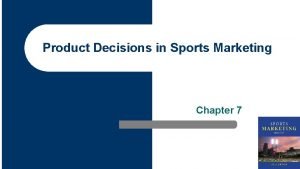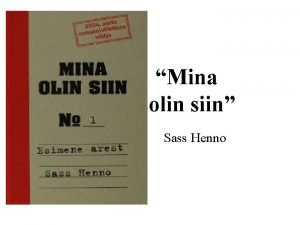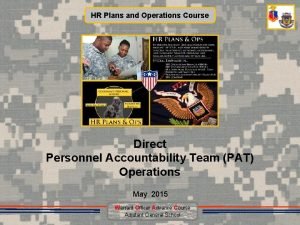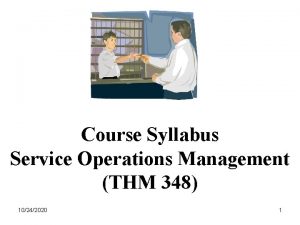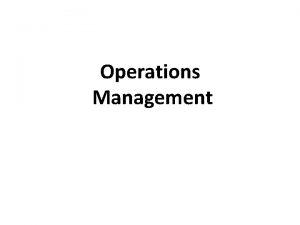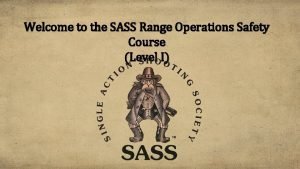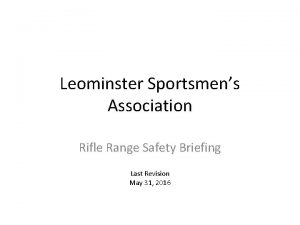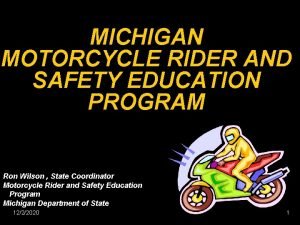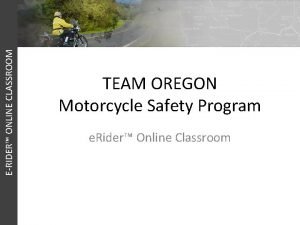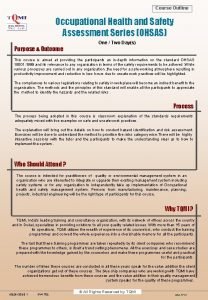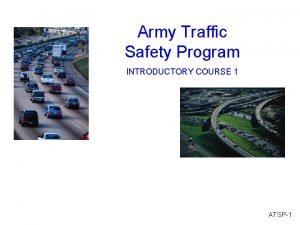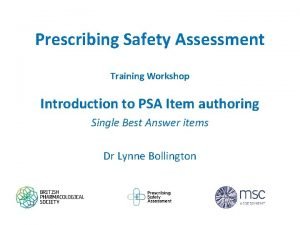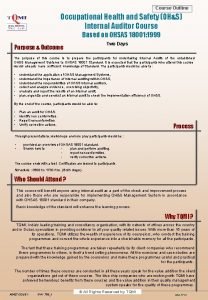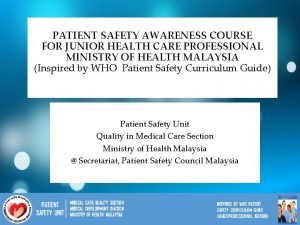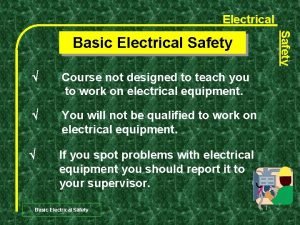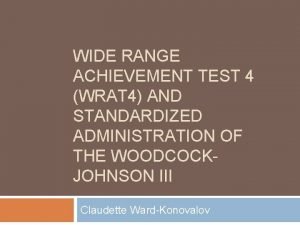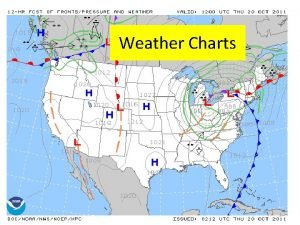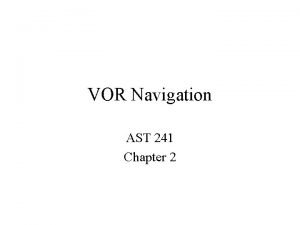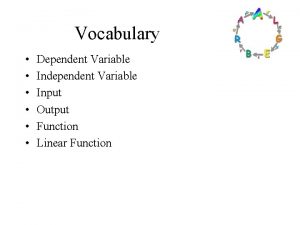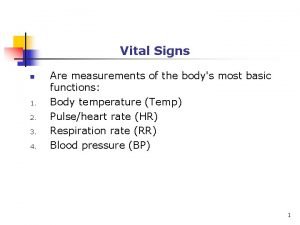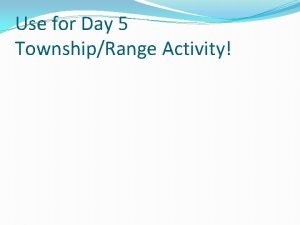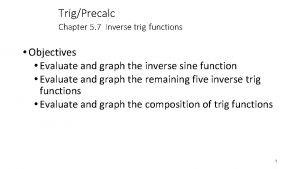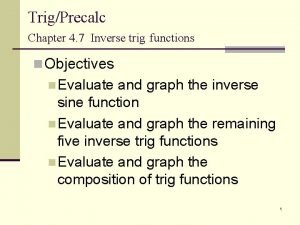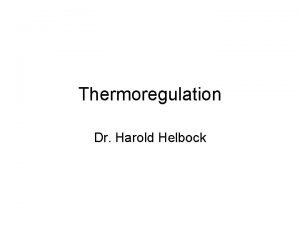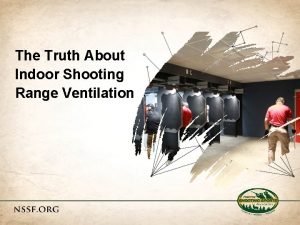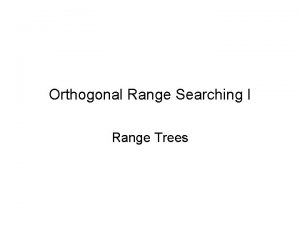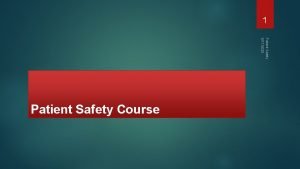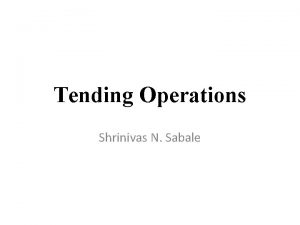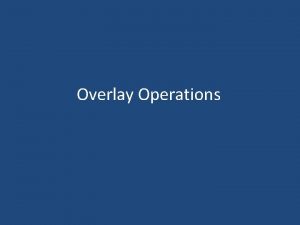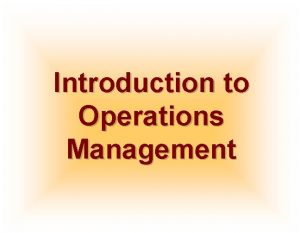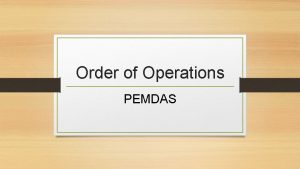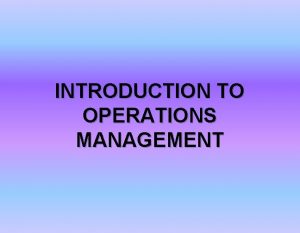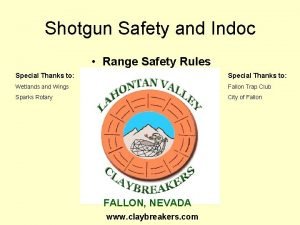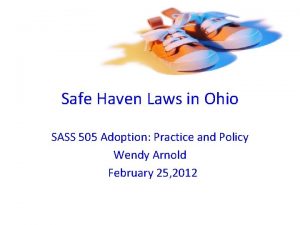Welcome to the SASS Range Operations Safety Course











































































































- Slides: 107

Welcome to the SASS Range Operations Safety Course (Level I)

Unit 1: Introduction to the SASS Range Operations Safety Course, Level 1 Lets Introduce Ourselves! ØInstructor Welcome and introductions ØStudent introductions: Include Name/Alias, location, and experience with SASS & Cowboy Action Shooting.

Course Expectations • Course scheduled time is approximately 4 -5 hours • Breaks will be given throughout the course • Please silence cell phones – step outside if you need to use your cell phone • The student course book matches the slide presentation Be on the look out for the star symbol throughout the course – you will see it again!

Course Goal To develop SASS Range Operations Safety Officers who possess the knowledge, skills, and attitude essential to ensure safety and consistency at all SASS Cowboy Action Shooting matches.

RO I Certification Course Requirements • Attend the entire course. • Participate in discussions and practical exercises. • Demonstrate knowledge, skills, and attitudes necessary. • Commit to know and understand the most recent version of the SASS Shooters Handbook and strive to stay informed. • Achieve a minimum examination score of 80% (24/30) • Have fun!

Purpose of SASS RO Training CONSISTENCY A standardized set of rules for all to follow eliminates “grey areas” that can lead to arguments, misunderstandings, and most importantly- ensures a safe environment for the enjoyment of the sport- no matter where you travel to shoot. EVERYONE is a SAFETY OFFICER

Unit 2: The SASS Shooters Handbook is the greatest resource available to all Shooters & Range Officers. Sections of Content relating the rules and regulations of SASS and the sport of Cowboy Action Shooting™ that directly impact the knowledge and education of Range Safety Officers as it relates to this course are compiled from information contained in the Handbook. Become familiar with the Handbook & reference it when enforcing the rules- it is your back up!


Unit 3: Cowboy Action Shooting Basics What is Cowboy Action Shooting? Cowboy Action Shooting™ is a multi-faceted shooting sport in which contestants compete with firearms typical of those used in the taming of the Old West: single action revolvers, pistol caliber lever action rifles, and side by side or pump-style shotguns. The shooting competition is staged in a unique, characterized, “Old West” style. It is a timed sport in which shooters compete for prestige on a course of different shooting stages and scenarios. Each scenario features an array of situations, many based on famous incidents or Western movie scenes- in which the shooters test their mettle utilizing all four firearms in a designated order and challenge, against steel targets.

Cowboy Action Shooting™ Basics Review & discuss the sample Shooting stage & shooting scenario provided *This course is not intended to be an introductory course to Cowboy Action Shooting™.

Unit 4: The Role of the SASS Range Safety Officer The purpose of trained Range Officers is to provide the sport of Cowboy Action Shooting™ with competent, firm, and fair officials in all levels of competition and to educate and empower certified Range officers to perform any duty on the posse. Range Officer’s Motto: The purpose of the Range Officer is to SAFELY ASSIST the Shooter through the course of fire.

SASS Range Officers 10 “Commandments” üSafety First üKeep it Fun üUse Common Sense üThe benefit of the doubt goes to the shooter üTreat everyone as you would like to be treated üTreat everyone equally (Sam Colt made us that way) üKeep the stage moving (if a problem arises, take it to the side) üMake sure all posse assignments are covered üCoach when needed üKeep it simple

What is a Chief Range Officer (CRO)? The Range Officer serving as the Timer Operator (TO) during any course of fire for any competitor, becomes the Chief Range Officer (CRO) for the Posse & Shooter as long as he/she is operating the timer. The Timer Operator (TO/CRO) serves as THE Range Officer for the shooter(s) they are timing…. The motto, again: . . to SAFELY ASSIST the shooter through the course of fire.

SAFELY ASSIST The 2 paramount words in the RO Motto are SAFELY ASSIST! Keys to a winning ASSIST: ü #1 Consistent Information & Communication ü #2 Assessment of the Shooter ü #3 Shooter Inventory ü #4 Anticipate ü #5 Attitude ü #6 Coaching

#1 Consistent Information & Communication Always give consistent, complete information about the stage and its navigation. Read provided stage descriptions word for word. • Be consistent in WHAT you say, and HOW you say it. • Established cadences help to alleviate misunderstandings and false starts, and can also help to calm a shooters nerves if they are clear on what to expect from their TO. Common cadence: (after the shooter has indicated ready) “Shooter Ready……pause……Standby……pause……. . beep”

#2 Assessment of the Shooter Assess the Shooters Condition We have all seen (or been) a shooter suffering from a case of nerves. Regardless of the experience level of the shooter, adrenaline is very powerful and can have adverse effects that can pose a danger. Violent shaking, trouble talking, and seeming “lost” about the stage requirements have all been reported. Some cases warrant gently suggesting that the shooter leave the shooting line, sit down, and wait a little longer before shooting the stage.

Assessment of the Shooter Additional Assessments of the Shooters Condition include staying alert for any signs of the use of any substance that may affect his or her ability to participate with a maximum state of awareness and in a completely safe manner. Safety is ALWAYS the #1 priority The consumption of alcoholic beverages is strictly prohibited for all persons, shooters, guests, range officers, and others in the area until all firearms have been stored and shooting is completed for the duration of the day. No shooter may ingest any substance that may affect their awareness- including both prescription and nonprescription drugs that may cause drowsiness or any other physical or mental impairment. – SASS Shooters Handbook

#3 Shooter Inventory Visually inventory each shooter at the line before you start your Range Commands. Do they have everything they need to complete the course of fire? ü Shotgun shells ü Eye Protection ü Ear Protection ü Required firearms ü Needed Ammo reloads

#4 Anticipate the Shooters next move. With time and experience, you will be able to anticipate the shooter’s next move. In doing so, you may prevent him or her from acquiring penalties or performing an unsafe act.

#5 Attitude is everything. The best Range Officers have the best attitude. If you can do your job well and have fun too, then you will find the posse and your fellow shooters will too. Your attitude sets the tone and the mood for the entire match!

Attitude • • Be courteous, considerate, and respectful. Always be firm, but fair. Don’t be intimidated- Make the call; and call them as you see them. Don’t be over-zealous, and don’t be harshly tough. Be helpful to the competitor. Always refer to the SASS Shooters Handbook when stating the rules. Never allow a shooter to badger, abuse, or argue with you or any other match official. Bring this type of behavior immediately to the Match Director or Range Master. • Always give the Shooter the benefit of the doubt. • Be positive, encouraging, and HAVE FUN!

#6 Coaching What is Coaching? • Coaching is the most direct way to assist the shooter after the course of fire has begun. The TO should coach only when someone looks like they need it- are they momentarily confused or lost, or if are they attempting to address the wrong target? • It is not your job to “shoot the stage” for the shooter, coaching him or her in every action. • Some shooters don’t like to be coached at all. • New shooters might require more coaching at first. • It is prudent to determine those shooters on the posse who may require a little more coaching and those who prefer no coaching at all.

Proper Coaching vs. Improper Coaching ü Proper coaching is not considered RO Interference and will never be grounds for a reshoot. üImproper coaching by the RO that either impedes the shooters progress or results in a procedural penalty may be grounds for a reshoot. üAny Procedural penalties are the responsibility of the shooter; an RO/TO who does NOT provide coaching, is not responsible for a shooters procedural penalties. NOT coaching does not waive any procedural penalties. ü “Coaching” is defined by guidance from the RO only- any instructions yelled out by the “Peanut Gallery” (Spotters, etc. ) that impede the shooters progress or results in a procedural penalty may be grounds for a reshoot.

SAFELY Safely assisting the shooter through a course of fire means “without incident”. • Course Design – Don’t be afraid to refuse to allow your posse to shoot an unsafe stage. Insist the stage be made safe before proceeding. • Watch the Gun – As a TO, in order to make exact calls and anticipate the shooter’s next move, watch the gun! By looking at the gun, you can identify target engagement, squib loads, warn the shooter if he or she is getting close to breaking the 170°, and stop the shooter if there is a problem. • Stay within Arm’s reach – In order to stop an unsafe act, the TO must be within arms length of the shooter. The TO should be positioned behind and off to the strong side of the shooter. Never let the shooter get away from you.

Reshoots/Restarts SASS matches above the club level are “no alibi” matches. Once the first round goes down range, the competitor is committed to the stage and must finish the stage to the best of his or her ability. Reshoots or Restarts are not awarded for ammunition or firearm malfunctions. However, if there is a range failure (props, timer, RO’s) that is beyond the competitor’s control, a restart may be granted. The competitor starts over clean- carrying only accrued safety penalties forward.

Reshoots/Restarts No reshoots/restarts will be given after the first shot goes downrange as determined by the CRO/TO and Match Director. EXCEPT for: • Prop or match equipment failure • A Range Officer impeded the progress of the Shooter (RO Interference) • Timer failure or Unrecorded time Example: an RO stops a shooter from completing a shooting sequence due to a suspected squib load, but the firearm turns out to be clear. The RO has impeded the progress of the shooter and a reshoot/restart is in order. The shooter starts over with no misses or penalties. (Except safeties)


Unit 5: Ammunition Components & Common Firearm stoppages & Malfunctions Ammunition Basics 2 types of Modern Ammunition Rimfire The firing pin strikes and crushes the bases rim to ignite the primer. Centerfire The firing pin strikes the primer cap at the center of the base of the case. The rim of the rimfire cartridge contains the priming compound, the case contains the powder and the bullet. Most commonly used type of modern ammunition. *Used in Cowboy Action Shooting™*

Black powder Ammunition Understanding the basics of loading a Black powder revolver Step 1 Step 2 Step 3 Pour a measured Place the ball Seat the bowl charge (powder) over the chamber using the loading into the chamber opening lever Step 4 Step 5 Step 6 Repeat with the remaining chambers Apply additional grease Place a percussion cap on each loaded chamber Due to the common use of Black powder firearms in Cowboy Action Shooting™, It is important for Range Officers to have a basic understanding of the ammunition and functioning of Black powder firearms.

Smokeless Ammunition Basic Components & Function of Ammunition

Ammunition Firing Sequence

Ammunition – SASS Standards The minimum standard for center-fire ammunition used in all smokeless categories in all SASS sanctioned competitions must: • Meet the minimum *power factor of 60 • Meet the minimum velocity of 400 fps • Maximum velocity standard for revolvers is 1000 fps • Maximum velocity standard for rifles is 1400 fps *Pocket pistols, derringers, and long-range rifles are exempt from the power factor and velocity requirements.

Firearm & Ammunition Malfunctions Malfunction- Failure of a firearm or ammunition to function as designed or fire satisfactorily. Two Types of Malfunctions: Gun Malfunction Ammunition Malfunction

Firearm Malfunctions A Gun malfunction is different from a Gun Stoppage- a stoppage is an unintentional interruption in the operational cycle of the gun. Stoppages can typically be cleared quickly, returning the gun back to operational condition. Malfunction- Failure of a gun or ammunition to function as designed or fire satisfactorily. *Firearm malfunctions require the gun to be repaired by a qualified gunsmith to return it to a properly functioning state.

Ammunition Malfunctions ü Misfire ü Squib load ü Hangfire ü Chainfire

Misfire A misfire is when a cartridge does not fire after the primer has been struck by the firing pin. Misfires typically do not require any handling. Understanding the occurrence of the misfire is key.

Squib Load A Squib load is when there is less than normal pressure or bullet velocity after ignition of the cartridge. • The bullet may or may not exit the barrel • Squib loads are usually identified by a difference in recoil or noise Procedure for handling a squib load: • Stop firing immediately • Keep the gun pointed down range, in a safe direction, or safely transport to the unloading table • Unload the gun – make sure the chamber is empty • Insert a rod down the barrel from the chamber end (if possible) to make sure the bullet is not lodged in the barrel

Hangfires Malfunction most commonly seen with Black Powder Ammunition There is no immediate method of determining a hangfire from a misfire. Taking precautions to understand be prepared for a possible hangfire with black powder shooters is crucial. Hangfire- a perceptible delay in the ignition of a cartridge after the primer has been struck by the firing pin. Procedure for handling a possible Hangfire: • Keep the gun pointed downrange (in a safe direction) • Wait at least 30 seconds in case it is a hangfire

Chain fires Exclusive to Cap & Ball Black powder Ammunition Chain firing- also known as Cross-firing references when multiple chambers discharge at the same time. Chain firing has several causes, most commonly, the powder can get between the ball and the chamber wall and without adequate grease, the flash can travel up and around the ball, into the neighboring chamber, and create a powder flash chain through all chambers. The result is the discharge of multiple chambers at the same time.

Lead Precautions An often overlooked aspect of shooter safety is exposure to lead. Lead exposure concerns are not limited to the Reloading process. Shooters handle lead ammunition while loading their firearms, and may be exposed to lead dust on the air on or near the firing line. Over time, lead exposure can result in lead levels that are higher than most Doctors recommend.


Unit 6 Range Safety Rules & Conventions

What is a Convention? Conventions refer to standard range behaviors, rules, and expectations. • ALL SASS Safety Conventions are not negotiable and shall never be overruled by match design or shooting course descriptions. • Stage Conventions are standard default rules unless otherwise directed by stage design/description (example: Knockdown targets must go down to count)

Range Safety Rules Everyone is a Safety Officer- but- it is the ultimate responsibility of the Range Officers to assure the safety rules are consistently followed. Enforcing all Safety Rules is not negotiable. SASS Rules supersede any site-specific (Range specific) safety rules that do not meet the minimum SASS Safety rules. If the Site/Range rules are more stringent than the SASS rules, or differ in disallowing an action that is allowed under SASS rules- the Site/Range rules are to be followed. (Above and beyond set SASS rules).

Shooters Responsibility Safe Gun Handling is the shooters responsibility. All shooters must demonstrate rudimentary familiarity and proficiency with the firearms being used. While monthly matches are certainly excellent training ground, SASS matches are not the forums in which to learn basic firearm handling. Basic firearm safety and rudimentary proficiency training are more appropriately learned under non-match conditions.

The Magnificent Seven 1. 2. 3. 4. 5. 6. 7. Always treat every firearm as if it is loaded Never let the muzzle of a firearm break the 170° rule Be sure of your target and what is beyond Keep your finger off the trigger until ready to fire Firearms remain unloaded outside of the normal course of fire- loading table to unloading table (Cold range) Treat all firearms with RESPECT SPEAK UP!

The 170° Rule 170° rule means that the muzzle of firearm must always be straight down range +/- 85° in any direction

Safety Rules – Revolvers Revolver Safety Conventions • Six-gun revolvers are ALWAYS loaded with only 5 rounds and the hammer lowered and resting on the empty chamber. • Five-shooter revolvers may load 5 rounds, but the hammer must rest on a dummy chamber or safety slot/pin in the cylinder to avoid the hammer resting on a live round/cap. • A cocked revolver may never leave a shooters hand- including from one hand to the other. *Does NOT APPLY when loading or reloading on the firing line • Cowboy Action Shooting™ is NOT a fast-draw competition. Any unsafe handling in the course of a draw from the holster or any “Fanning” to shoot a revolver is strictly forbidden. *Note: Slip-hammering is not the same as fanning and is legal

Safety Rules – Revolvers Safe conditions of revolvers during a course of fire Revolvers are considered SAFE for movement (in hand, while holstering, while moving through a stage, and safe to leave the shooters hand) in the following condition ONLY: • Hammer fully down on an empty chamber • Hammer fully down on an expended round *a revolver may not be originally staged in this condition, but may be restaged in this condition GUNFIGHTER considerations: When shooting “Gunfighter”, a gunfighter may not holster revolvers with the intent to engage another revolver sequence.

Safety Rules – Revolvers • • Revolver Staging & Handling Conventions Revolvers are drawn and used in accordance with the shooter’s category. Revolvers are returned to leather (in a safe condition) after the shooting string De-cocking is not allowed on the firing line once a round has gone downrange. Once a revolver is cocked, the round must be expended (shot) under the direction and supervision of the Timer Operator (TO). When drawing a Revolver from its holster, the revolver may not be cocked until it is at a 45° angle downrange.

Safety Rules – Rifles Rifle Staging and Handling Conventions • Rifles may be staged with the magazine loaded, action closed, hammer fully down on the empty chamber (not on the safety notch), as long as the muzzle is pointed in a safe direction – adheres to the 170° safety rule, and the muzzle is never on the ground. • Rifles will be cleared and discarded with their barrels pointing in a safe direction. If the action of a rifle closes after being cleared, the shooter will, at the conclusion of the stage, show it to be clear to the TO. No person other than the competitor may handle the long gun prior to opening the action and showing it to be clear. • If the rifle is the last firearm used (rare- not suggested!), it must be cleared prior to it leaving the shooters hand(s) at the unloading table. *This does not apply to firearms shot out of sequence, made safe, and then restaged.

Safety Rules – Rifles Safe conditions of a rifle during a course of fire A Rifle is considered SAFE to leave the shooters hands in the following condition ONLY: • Empty • Hammer fully down on an empty chamber or spent round, action closed (restaged for further use) A Rifle is considered SAFE for movement (in hand, while moving through a stage) in the following condition ONLY: • Hammer fully down on an empty chamber or expended round, action closed • Action open, round on carrier or in chamber

Safety Rules – Shotguns Shotgun Staging and Handling Conventions • Shotguns are always to be staged open and empty • Shotgun targets may be re-engaged until down, unless otherwise specified by the stage description. • Shotgun Shells may be removed without penalty to return the firearm to a safe condition • Shotguns will be cleared and discarded with their barrels pointing in a safe direction. If the action closes after being cleared, the shooter will, at the conclusion of the stage, show it to be clear to the TO. No person other than the competitor may handle the gun prior to opening the action and showing it to be clear.

Safety Rules – Shotguns Safe conditions of a shotgun during a course of fire A Shotgun is considered SAFE to leave the shooters hands in the following condition ONLY: • Empty A Shotgun is considered SAFE for movement (in hand, while moving through a stage) in the following condition ONLY: • Action open, round in chamber or on carrier • Hammer(s) fully down on empty chamber(s) or expended round(s), action closed

Safety Rules – All Firearms • • • Firearm Safety & Handling Conventions All staged guns shall have their barrels pointed in a safe direction. All long guns initially staged on a horizontal surface shall be staged laying flat where at least the rear of the trigger guard is on the staging area. All handguns initially staged on a horizontal flat surface must be staged with the entire handgun on the staging surface. All firearms will remain unloaded except while under direct observation of a designated person on the firing line or in the designated loading and unloading areas. The muzzles of all long guns must be maintained in a safe direction (generally “up” and slightly down range) at all times.

Safety Rules – All Firearms Firearm Safety & Handling Conventions • As long as the shooter has contact with the firearm, it is considered as still in their control. • Any unloaded firearm dropped during a stage will result in a stage disqualification. • Any loaded firearm dropped during a stage will result in a match disqualification. *A shooter is forbidden from picking up a dropped firearm. The Range Officer will recover the firearm, examine it, clear it (if necessary), return it to the shooter, and assess the appropriate penalty

Safety Rules – Ammunition Conventions for Ammunition • Shooters may not start a stage with ammunition in hand(s) • Any ammunition dropped by a shooter in the course of reloading any firearm during a stage or ejected from any firearm may be retrieved and replaced, or, alternatively, must be replaced from the shooters person or other area as allowed by stage description. • Dropped rounds or rounds safely placed onto a prop from their original loading area may be recovered and used. *In both cases above, the recovery of a dropped or safely placed round must be performed carefully as to not create a loss of muzzle control. Breaking the 170° carries a significant penalty – up to a Match Disqualification.

Safety Rules – Ammunition Conventions for Ammunition • Illegally acquired ammunition- any ammunition not carried to the line and/or staged by the shooter in an approved manner. • Failure to bring enough ammunition to the line to complete a stage is scored the same as misses for any un-fired rounds. • Unfired, ejected rifle rounds may be replaced (reloaded) on the clock during a stage. • Inadvertently leaving unfired rounds in a revolver is a miss. *Unless the round is under the hammer- then the penalty is a Stage Disqualification. • A live round left in the chamber of a long gun carries a Stage Disqualification penalty. • A live round left in the magazine or on the carrier, as well as an empty round left in the chamber, magazine, or on the carrier of the firearm in which it was loaded, results in a Minor Safety Violation. *Malfunctioning firearms still containing rounds will not warrant penalties so long as the malfunction is declared and the firearm is made safe.

Safety Rules – Uncontrolled Discharge Conventions for an Uncontrolled Discharge- the discharge of a firearm that was not controlled by the shooter- either by accidental discharge or by shooting a round in an unsafe manner (ie: over the berm). • A round over the berm *Site specific match & range rules establish the penalty, up to and possibly including a Match Disqualification. • Uncontrolled discharges have penalties: • Within 5 -10 feet from the shooter while on the stage: Stage Disqualification • Less than 5 feet from the shooter while on the stage, any discharge at the loading or unloading areas, any discharge off the firing line, or any discharge that is deemed unsafe: Match Disqualification Note: Match Directors have the latitude to place props so that shooters must negotiate them. In doing so, Match Directors may declare props as expendable (shootable) without penalty.

Safety Rules – Participant Performance & Conduct Conventions for Participant Performance • The shooter must obey all range commands given by the RO/TO • Safe gun handling is the shooters responsibility • The shooter with firearm in hand shall never be allowed to move with a live round under a cocked hammer. Movement is defined as the same as “travelling” in basketball. Once the firearm is cocked, one foot must remain in place on the ground until the firearm is made safe. Shuffling the feet to maintain balance or adjust the shooting stance is allowed as long as the shooter does not actually change location. • “Shooting on the Move” is expressly disallowed. See guidelines for the safe condition of firearms for movement.

Safety Rules – Participant Performance & Conduct • • Conventions for Participant Performance Once a shooter is committed to the stage (first round goes down range) the shooter must remain on the stage until it is completed and the shooter has moved to the unloading area to clear all firearms. Firearm and ammunition staging is the sole responsibility of the shooter. Understanding the course of fire is the sole responsibility of the shooter. All participants must demonstrate rudimentary familiarity and proficiency with the firearms being used. All shooters are responsible for knowing the condition of their firearms, their safe operation, and the correct loading and unloading procedures. Eye Protection is mandatory. Hearing protection is highly recommended.

Safety Rules – Participant Performance & Conduct • • • Conventions for Participant Conduct Good Sportsmanship best defines “Spirit of the Game”. Be a good sport. Have fun- this event is solely for the safe enjoyment of the participants. Interpersonal conflicts will not be tolerated. Any shooter, guest, or match official who uses foul language, is disrespectful, offensive, rude, or becomes belligerent or threatening in any manner will be disqualified from the event, and, at the Match Directors discretion, may be required to leave the property. Alcoholic beverages are prohibited in the shooting area for all persons; shooters, guests, range officers, and others until all shooting is over for the day and firearms have been stored. *Site specific range rules must be taken in to account. A violation of this rule results in a Match Disqualification penalty. No participant may ingest any substance that may affect his or her ability to participate with a maximum state of awareness and in a completely safe manner. (Prescription and nonprescription drugs that may cause drowsiness or any other physical or mental impairment). A violation of this rule results in a Match Disqualification penalty.

SASS Stage Conventions The following stage conventions (stage defaults) should be followed in all SASS matches – unless otherwise directed in the stage descriptions • All knockdown shotgun targets may be reengaged until down. • All knockdown targets (shotgun, rifle, or revolver) must go down to count. • Any knockdown target still standing once the shooter has engaged the next sequence of the stage will be counted as a miss. • Exception: Buckaroo/Buckarette Shooters- SG targets do not have to go down to count. • If no starting position is given, the shooter shall stand upright with revolvers holstered, hands at the sides- not touching any firearm. (SASS default) • Cowboy port-arms is defined as standing upright with the butt of the long gun at or below the waist of the shooter, the muzzle at or above the shoulder, and the long gun held with both hands.


Unit 7: Range Commands Standard Range Commands are the most efficient way to run a shooting line and are used in almost every established shooting sport. Standard Commands allow shooters from all over the world to understand range procedures- even if they don’t speak English fluently. Range Commands don’t have to be recited word-for-word, but the closer the better. Adding a little fun and western flavor associated with our game allows for colorful individuality. ready? ” *For example: “Is the shooter ready? ” can also be “Is the cowboy/cowgirl Safety, Efficiency, and HAVING FUN can all co-exist! SPEAK UP when giving Range Commands!

Range Commands – The FLAG System On ranges where multiple stages are run in parallel using a common firing line with no separating side berms, Visual cues aid in the quick communication of Range Safety statuses between shooting posses. *Flags are often used in conjunction with a horn or a whistle to increase notification awareness.

Range Commands – The FLAG System YELLOW FLAG Once the “Yellow Flag” command has been given, each stage affected will allow any shooter already engaged in that stage to complete the course of fire. As shooting finishes on each stage, all in-use guns are laid down at the loading and/or unloading areas and the competitors “Stand back”. Once the firearms are secure, each stage will signal compliance by raising its own yellow flag. When all affected stages are displaying their yellow flag, the initiating RO can advance down range. When the down range work is completed, an “ALL CLEAR” command will be given, the Yellow flags withdrawn, and normal range operations can resume.

Range Commands – The FLAG System RED FLAG “RED FLAG” means “CEASE FIRE!” All shooting must IMMEDIATELY stop, all firearms must be laid down or otherwise made safe. Once the Cease Fire condition is resolved, an “ALL CLEAR” command is given, the Red Flags are withdrawn, and normal range operations are resumed. *Any shooter stopped while shooting a stage is given a reshoot.

Unit 8: Match Positions & Roles All match positions covered in this lesson are Considered Range Officers. Each position serves a critical function to the fair, efficient, and SAFE execution of a match.

Match Director & Range Master Match Director is in charge of the overall match and is required to ensure qualified officials are in place in all competition areas. The match director is typically the stage writer/designer of the match. Range Master is in charge of and oversees all stages and ensures qualified officials are in place in all stages. He reviews all stages and ensures they are designed and constructed to operate in a safe manner for both competitors and officials.

The Posse Marshal & Deputy ü Is in charge of a posse and are required to ensure all positions are manned to safely and efficiently run the posse through each course of fire. ü Ensures that all rules and regulations are being followed ü Must understand all stages, conduct a walk-through, and answer all questions before each stage. ü Will appoint at least one Posse Marshal deputy to assist if one is not assigned. DEPUTY Posse Marshals: ü Acts on behalf of the Posse Marshal when the Marshal is shooting or otherwise unavailable *The Marshal & Deputy should be separated in the shooting order for adequate Posse coverage. *It is highly recommended that anyone serving in a Posse Marshal or Deputy Posse Marshal capacity be trained in this RO 1 Course.

The Timer Operator (TO) is the Chief Range Officer (CRO) for the stage and is in charge of the firing line as long as he/she is running the timer. The TO’s primary objective is: …to SAFELY ASSIST the Shooter through the course of fire.

The Timer Operator (TO) The Timer Operator is IN CHARGE of the Firing Line. The TO and the Spotters: ØThe TO identifies and assigns 3 Spotters. *The TO does not spot or count misses- but can provide insight if there is a question due to the vantage point of the TO to the shooter. Ø The TO immediately announces the stage time to the shooter at the completion of the stage. ØThe TO polls the 3 spotters to determine the number of misses and solicits their input regarding any penalties ØThe TO calls those numbers to the Score keeper and Competitor in a loud, clear voice.

The Timer Operator (TO) The Timer Operator is IN CHARGE of the Firing Line. Standard TO Cadence/Firing Line Order: 1. 2. 3. 4. 5. 6. 7. 8. 9. The TO assigns 3 Spotters The TO ensures the firing line is ready for the next shooter; targets reset, etc. The TO calls the next Shooter to the line – Assess the Shooter The TO watches, guiding if necessary, the gun staging process The TO asks the shooter if they understand the course of fire- answer questions if needed The TO ensures the shooter is starting in the correct position Upon the ready indication by the Shooter, the TO: “Shooter ready……Standby……. . beep” At the conclusion of the stage, the TO immediately calls out the time to the shooter The TO directs the Shooter to the unloading area. Upon the shooters departure from the line (with all firearms), the TO declares the “All clear” indicating the line is safe to reset targets, pick brass, etc. 10. The TO polls the Spotters regarding misses 11. The TO announces the time and any misses/penalties to the Score Keeper and the shooter 12. The TO ensures the firing line is ready for the next shooter; targets reset, etc. . . AND THE CYCLE CONTINUES

Expeditor (XP) Officer • The Expeditor (XP) Officer facilitates and speeds up the progress of the shooters in line for the firing line. • In large matches, the XPO is in charge of making sure the posse stays on time and on task during their assigned time on each stage. • Not all matches will benefit from an XPO, but the majority of time lost in a match is in getting the next shooter to the line and staging their firearms. Used correctly, the XPO can shave up to 30 seconds per shooter in contestant transitioning.

Spotters • Spotters have the responsibility to count shots and misses and to verify the targets were engaged in the correct order for the required number of shots. • Spotters assist the TO by watching for violations when the competitor retrieves staged firearms and draws revolvers since it is impossible for the TO to have an unobstructed view of both sides of the competitors body. • Spotters are obligated to stop a shooter from attempting an unsafe action if the TO is not in position to see it or react quickly enough.

Spotters • Determine misses by both visual and audible means, when possible. • Should always be in a position to see all the targets in the course of fire. At least one spotter should be positioned on each side of the competitor. • There should always be 3 spotters. The majority (2 out of 3) breaks the tie in regard to misses. • Spotters should be easily identifiable by holding a baton, wearing a bandana, etc. • The TO is not relied upon to count shots and misses. • Spotters declare any misses and procedurals at the conclusion of the stage • Spotters never spot for a family member.

Spotters Always give the shooter the benefit of any doubt. If you know it’s a HIT…. . IT’S a HIT! If you think it’s a MISS…. IT’s a HIT! If you know it’s a MISS…. IT’s a MISS!

Score Keeper • It is good practice for the Score Keeper to repeat the times and penalties back to the TO in a loud, clear voice for confirmation. • The Score Keeper records the times and penalties appropriately for each contestant on the provided score sheets for each stage. • The Score Keeper should total the times and penalties to calculate the shooter’s score – if the scoring instructions dictate. • The Score Keeper can also be a Spotter. • A Score Keeper must never record the score of a family member. • The shooter should be made aware of any misses or penalties as they are leaving the line. Especially since once they leave the line and unload, miss penalties should not be questioned.

Score Keeper – Score Sheets Sample Common Score Sheet (A): SHOOTER NAME RAW TIME MISSES Fast Shooter 19. 3 1/5 Sassy Shooter 37. 6 Wild Shooter Sweet Shooter PENALTY TOTAL TIME 24. 3 1 P/10 47. 6

Score Keeper – Score Sheets Sample Common Score Sheet (B): SHOOTER NAME RAW TIME MISS 19. 3 1 PROCEDURALS /MSV SDQ MDQ BONUS TOTAL TIME 24. 3 Fast Shooter 37. 6 Sassy Shooter 1 47. 6

Scoring Methods Cowboy Action Shooting™ SASS Approved Scoring Methods: • Total time • Most commonly used method in matches up to State Championship level • Stage Point Scoring • Used in all WBAS matches, approved for use in CAS matches • Rank Point Scoring • Rewards the most consistent shooter • Required scoring method for Regional, Divisional, National, and World Championship matches

Loading Table Officer The loading table officer is responsible for visually checking to ensure all firearms are loaded with only the correct number of rounds required in a course of fire, to verify that no round is ever under the firing pin of any firearm, and that all loaded firearms’ hammers are fully down on an empty chamber. *At the loading table, Shooters are allowed to make corrections as necessary without penalty. • Leaving the loading table with a hammer not fully down on an empty chamber, or with a round under the firing pin of any firearm has a penalty of a Stage DQ.

Unloading Table Officers are responsible for visually checking to ensure all firearms are UNLOADED after the completion of the shooting stage.

Loading & Unloading Table Conventions All firearms will remain unloaded except while under the direct observation of a designated person on the firing line or in the designated loading and unloading areas. Any competitors failure to adhere to loading & unloading procedures will result in a penalty of a Stage Disqualification. • Leaving the unloading table without clearing all firearms will result in the penalty being assessed on the stage where the infraction was committed. • Competitors shall not leave the designated loading area with a loaded firearm unless they are proceeding to the stage as the next competitor to begin the stage.

Loading & Unloading Table Officers REMEMBER: The primary responsibility always rests with the competitor. Shooters should always know the condition of their firearms and should never depend upon the Loading and Unloading Officers to ensure their firearms are correctly loaded or unloaded. The Loading & Unloading Officers are an added measure of safety. The competitor may never blame the Loading officer for an incorrectly loaded firearm- or an Unloading officer for a firearm not unloaded. *At no time will this claim be grounds for dismissal of penalties.

Berm Marshal (aka: Stage Driver or Stage Marshal) The role of Berm Marshal has mostly been eliminated in matches. The Posse Marshal walk-thru process and the role of the Posse Marshal has eliminated the need for Berm Marshals. *While the role has been mostly eliminated, some Match Directors MAY still enlist the role of Berm Marshal into their matches. As such, the duties and process of the role of Berm Marshal are explained in this course.


Unit 9 Outlawed (Illegal) Items & Holster Standards

Illegal (Outlawed) Items The current version of the SASS Shooters Handbook contains a complete listing of Outlawed items. The use or presence of an outlawed item is a Stage Disqualification. Examples: • Modern Shooting gloves • Short sleeved shirts (Male competitors only) • Designer jeans • Ball caps • Tennis, running, jogging, aerobic, or other modern athletic shoes • Apparel displaying manufacturer, sponsors, or team logos.

Illegal Firearm Modifications The current version of the SASS Shooters Handbook contains a complete listing of all LEGAL modifications made to firearms. Any modification not listed in the SHB are ILLEGAL A Stage DQ is issued for each stage in which a non-SASS legal firearm is used.

Holster & Belt Conventions • All handguns must be carried in a safe holster capable of retaining the firearm throughout a normal range of motion. • Two revolvers may not be worn on the same side of the body. • Main match revolvers must be located one on each side of the belly button and separated by at least the width of two fists at the belt. • Shotgun belts must be worn at or below the bellybutton *A full listing of all Holster requirements, rules, and standards are outlined in the SASS Shooters Handbook.

Holster Standards Holsters must NOT depart from the vertical by more than 30° when worn: Illegal Legal

Cross Draw & Shoulder Holsters Cross Draw Holsters and Shoulder Holsters require extra care on the part of the competitor to ensure: • No holster may depart from the 30° when worn • When drawing a revolver the user must twist their body (if necessary) to ensure the muzzle never breaks the 170° rule.

Unit 10 Penalty Assessments

Types of Penalties • 5 -second Penalties • 10 -second Penalties • Stage Disqualification • Match Disqualification • Failure to Engage/Spirit of the Game

5 -second Penalties *MISSES are 5 -second Penalties* Revolver, Rifle, and Shotgun targets must be engaged with the appropriate type of firearm. • A MISS is defined as the failure to hit the appropriate target type using the appropriate type of firearm. Includes: • Each missed target • Each unfired round • Inadvertently left rounds in a revolver are misses (unless there is an unfired round under the hammer- then it is a stage DQ) • Each target hit with an incorrect firearm, either intentionally or by mistake • Each target hit with “illegally acquired” ammunition. *DOUBLE JEOPARDY: A MISS CANNOT CAUSE A PROCEDURAL*

Miss Flow Chart

10 -second Penalties Procedural Penalties (P) are any unintentional procedural error caused by “brain fade”, confusion, ignorance or mistakes. Procedural errors carry a 10 second penalty and cannot exceed one for any given stage. *Each of these penalties is stand alone and not to be added one on top of the other. *DOUBLE JEOPARDY: A MISS CANNOT CAUSE A PROCEDURAL

10 -second Penalties MINOR SAFETY VIOLATION (MSV) Actions that result in a MSV Penalty include: • Leaving empty or live rounds in magazine or carrier of the long gun in which it was loaded • Open, empty long guns that slip and fall but do not break the 170° safety rule or sweep anyone • Cocking a revolver before it reaches 45° down range

Stage Disqualification (SDQ) Penalty Stage Disqualification (Stage DQ or SDQ): the competitors time and performance on the course of fire is disqualified as a result of the violating action by the shooter. In the SDQ penalty, the shooter receives a score/time of 999. 00 (Rank Point Scoring).

Failure to Engage/Spirit of the Game 30 second Penalty • Willfully shooting a stage other than the way it was intended in order to gain a competitive advantage • Shooting ammunition that does not meet the power factor, minimum velocity. The penalty is applied for each stage a competitor is checked and their ammunition is found not to meet the power factor or minimum velocity. • Willfully refusing to make an attempt to complete any non-shooting procedure written within the stage instructions (rope a steer, throw a stick of dynamite) *The accumulation of 2 Spirit of the Game/Failure to Engage penalties result in a Match Disqualification.

Match Disqualification (MDQ) Penalty A MDQ means the shooter puts his/her firearms away and is done shooting for the duration of the match.


Final Review & Questions


CONGRATULATIONS! COURSE COMPLETE THANK YOU for taking the SASS RO I COURSE
 Sass double ampersand
Sass double ampersand Sports product marketing
Sports product marketing Mina olin siin kokkuvõte
Mina olin siin kokkuvõte Sports 1 marketing
Sports 1 marketing Sass stylus
Sass stylus Millikan-versuch auswertung
Millikan-versuch auswertung Sass henno
Sass henno Larry sass mit
Larry sass mit As compared to long-range forecasts, short-range forecasts
As compared to long-range forecasts, short-range forecasts Wise men three clever are we
Wise men three clever are we You are welcome my dear
You are welcome my dear Hr plans and operations course
Hr plans and operations course Operations management course syllabus
Operations management course syllabus Operation management course outline
Operation management course outline Half brick wall
Half brick wall Course title and course number
Course title and course number Course interne course externe
Course interne course externe Range safety rules
Range safety rules Leominster sportsmen's club
Leominster sportsmen's club 12 golden rules of gun safety
12 golden rules of gun safety Tractor safety course oregon
Tractor safety course oregon Hse culture ladder
Hse culture ladder Basic rider course michigan
Basic rider course michigan Oregon motorcycle safety course
Oregon motorcycle safety course Occupational health and safety assessment series
Occupational health and safety assessment series Army traffic safety training program
Army traffic safety training program Prescribing safety assessment
Prescribing safety assessment Occupational health and safety course outline
Occupational health and safety course outline 13 malaysian safety goals
13 malaysian safety goals Osa safety course
Osa safety course Nevada boaters safety course
Nevada boaters safety course Army traffic safety introductory course
Army traffic safety introductory course Basic electrical safety course
Basic electrical safety course Oregon motorcycle training
Oregon motorcycle training Canadian patient safety officer course
Canadian patient safety officer course Hát kết hợp bộ gõ cơ thể
Hát kết hợp bộ gõ cơ thể Bổ thể
Bổ thể Tỉ lệ cơ thể trẻ em
Tỉ lệ cơ thể trẻ em Chó sói
Chó sói Chụp tư thế worms-breton
Chụp tư thế worms-breton Chúa yêu trần thế alleluia
Chúa yêu trần thế alleluia Môn thể thao bắt đầu bằng từ đua
Môn thể thao bắt đầu bằng từ đua Thế nào là hệ số cao nhất
Thế nào là hệ số cao nhất Các châu lục và đại dương trên thế giới
Các châu lục và đại dương trên thế giới Cong thức tính động năng
Cong thức tính động năng Trời xanh đây là của chúng ta thể thơ
Trời xanh đây là của chúng ta thể thơ Mật thư anh em như thể tay chân
Mật thư anh em như thể tay chân 101012 bằng
101012 bằng độ dài liên kết
độ dài liên kết Các châu lục và đại dương trên thế giới
Các châu lục và đại dương trên thế giới Thơ thất ngôn tứ tuyệt đường luật
Thơ thất ngôn tứ tuyệt đường luật Quá trình desamine hóa có thể tạo ra
Quá trình desamine hóa có thể tạo ra Một số thể thơ truyền thống
Một số thể thơ truyền thống Bàn tay mà dây bẩn
Bàn tay mà dây bẩn Vẽ hình chiếu vuông góc của vật thể sau
Vẽ hình chiếu vuông góc của vật thể sau Nguyên nhân của sự mỏi cơ sinh 8
Nguyên nhân của sự mỏi cơ sinh 8 đặc điểm cơ thể của người tối cổ
đặc điểm cơ thể của người tối cổ V cc cc
V cc cc Vẽ hình chiếu đứng bằng cạnh của vật thể
Vẽ hình chiếu đứng bằng cạnh của vật thể Vẽ hình chiếu vuông góc của vật thể sau
Vẽ hình chiếu vuông góc của vật thể sau Thẻ vin
Thẻ vin đại từ thay thế
đại từ thay thế điện thế nghỉ
điện thế nghỉ Tư thế ngồi viết
Tư thế ngồi viết Diễn thế sinh thái là
Diễn thế sinh thái là Dạng đột biến một nhiễm là
Dạng đột biến một nhiễm là Số nguyên tố là
Số nguyên tố là Tư thế ngồi viết
Tư thế ngồi viết Lời thề hippocrates
Lời thề hippocrates Thiếu nhi thế giới liên hoan
Thiếu nhi thế giới liên hoan ưu thế lai là gì
ưu thế lai là gì Khi nào hổ mẹ dạy hổ con săn mồi
Khi nào hổ mẹ dạy hổ con săn mồi Sự nuôi và dạy con của hươu
Sự nuôi và dạy con của hươu Sơ đồ cơ thể người
Sơ đồ cơ thể người Từ ngữ thể hiện lòng nhân hậu
Từ ngữ thể hiện lòng nhân hậu Thế nào là mạng điện lắp đặt kiểu nổi
Thế nào là mạng điện lắp đặt kiểu nổi Safety depth formula in ecdis
Safety depth formula in ecdis Qbs safety care
Qbs safety care Personal safety vs process safety
Personal safety vs process safety Safety assessment for ind safety reporting
Safety assessment for ind safety reporting Basic safety (construction site safety orientation)
Basic safety (construction site safety orientation) Basic safety construction site safety orientation
Basic safety construction site safety orientation Bb clarinet range
Bb clarinet range Wrat 4 scoring
Wrat 4 scoring White sands missile range
White sands missile range Bis monitor ranges
Bis monitor ranges What is a good quantile score
What is a good quantile score Basal metabolic rate
Basal metabolic rate Low level prognostic chart
Low level prognostic chart Terminal vor range
Terminal vor range Rectangular survey system ap human geography
Rectangular survey system ap human geography What is dependent and independent variable
What is dependent and independent variable Rectal temperature range
Rectal temperature range Respiratory rate chart
Respiratory rate chart Normal vitals for adults
Normal vitals for adults Respiratory rate normal
Respiratory rate normal God pod assay
God pod assay Township and range aphg
Township and range aphg What is the range for an ikea store ap human geography
What is the range for an ikea store ap human geography Normal pulse rate
Normal pulse rate Iq test score range
Iq test score range Range of inverse sine function
Range of inverse sine function Range of arc tan
Range of arc tan Pulse points of the body
Pulse points of the body Thermogenesis
Thermogenesis Indoor shooting range ventilation
Indoor shooting range ventilation Average rainforest temperature
Average rainforest temperature

